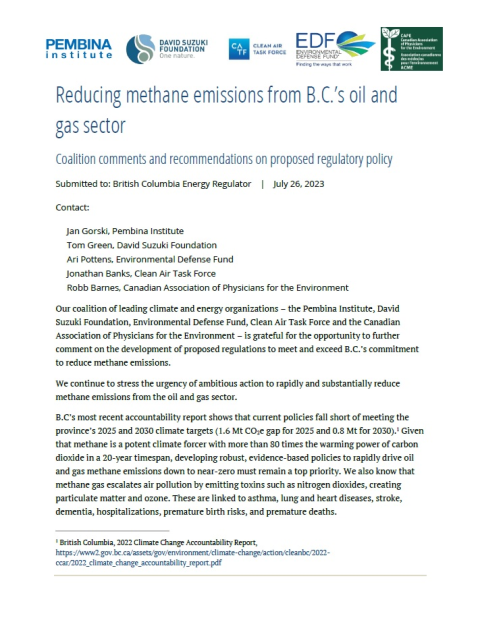Our coalition of climate and energy organizations – the Pembina Institute, David Suzuki Foundation, Environmental Defense Fund, Clean Air Task Force and the Canadian Association of Physicians for the Environment – is grateful for the opportunity to further comment on the development of proposed regulations to meet and exceed B.C.’s commitment to reduce methane emissions.
We continue to stress the urgency of ambitious action to rapidly and substantially reduce methane emissions from the oil and gas sector.
B.C’s most recent accountability report shows that current policies fall short of meeting the province’s 2025 and 2030 climate targets (1.6 Mt CO2e gap for 2025 and 0.8 Mt for 2030).1 Given that methane is a potent climate forcer with more than 80 times the warming power of carbon dioxide in a 20-year timespan, developing robust, evidence-based policies to rapidly drive oil and gas methane emissions down to near-zero must remain a top priority. We also know that methane gas escalates air pollution by emitting toxins such as nitrogen dioxides, creating particulate matter and ozone. These are linked to asthma, lung and heart diseases, stroke, dementia, hospitalizations, premature birth risks, and premature deaths.
B.C.’s proposed regulatory policy lags leading regulatory best practices in the exceedingly long timelines it proposes for existing facility rules and leaves a key component – compressor engine exhaust – undeveloped. As such, we strongly urge the BCER to strengthen and improve it as outlined below.
We support the following aspects of the planned regulatory approach and urge that they be preserved as the regulations are further developed:
- Integrating vital measurement-based information from airplane surveys into climate modeling and regulatory development. Studies have consistently demonstrated the inaccuracy of bottom-up estimation based on emissions factors, as well as the need for empirical measurement and monitoring.2 When regulatory development integrates empirical emissions data, regulations will reflect actual emissions, enabling meaningful progress toward reduction targets.
- Minimizing non-routine venting and prohibiting routine venting from most sources at new facilities as of 2025.
- Reducing emissions from tanks. Requiring operators to install thief hatch monitoring systems to quickly identify and alert operators to open hatches and thereby prevent significant tank emissions.
- Integrating alternative LDAR pathways that recognize the rich and rapidly evolving technological landscape for measurement and quantification of methane emissions.
- Minimizing emissions from maintenance activities by requiring operators to control emissions from planned pipeline blowdowns where technically feasible as of 2025.








